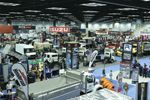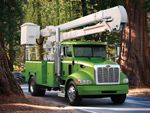Green News
ACT Expo Highlights
Nearly 200 alternative fuel and clean transportation industry leaders were on hand at the Alternative Clean Transportation Expo in May to present information on key advancements in alternative fuels and clean vehicles, including electric, hybrid, hydrogen, natural gas, propane autogas, clean diesel and renewable fuels technologies.
The 2014 ACT Expo, co-located with the NGV Global conference, also provided off-site technical tours of local alternative fuel vehicle and infrastructure projects; fueling, equipment, technology and vehicle displays; and a ride-and-drive with the latest light-, medium-, and heavy-duty alternative fuel and clean technology vehicles. More than 175 suppliers of alternative fuels and clean vehicle technologies sponsored the joint conferences.
A record number of propane autogas exhibitors, including propane autogas retailers and original equipment manufacturers, presented their latest solutions at ACT Expo. Included were Alliance AutoGas, CleanFUEL USA, Freightliner Custom Chassis Corp., Icom, Isuzu, New Eagle, Power Solutions International, Powertrain Integration and ROUSH CleanTech.
At the Propane Education & Research Council display, a ROUSH CleanTech E-450 transit shuttle bus and the newly released MT45 strip chassis from Freightliner Custom Chassis Corp. were on display. PERC also showcased new flat-tank fuel storage technology from Propane Performance Industries, an Exmark Lazer Z S-Series propane-powered lawn mower with a Kohler EFI power-plant engine, and a Superior Energy Systems autogas dispenser.
The newest additions to Peterbilt’s lineup of natural gas-powered commercial vehicles, including the vocational Model 567, were on display during the ACT Expo. The 567 is equipped with a Cummins Westport ISX12 G CNG engine and Quantum Fuel Systems Technologies Worldwide’s back-of-cab CNG fuel storage solution that uses the company’s Q-Lite tank technology and can store 123 diesel gallon equivalent (DGE) of fuel.
Mack’s natural gas-powered Pinnacle models at ACT Expo included axle-back models with both LNG and CNG power supplied by a Cummins Westport ISX12 G engine. Mack Trucks, which also offers natural gas-powered TerraPro models, recently introduced an LR series refuse vehicle and plans to announce a natural gas-powered version of the Mack Granite.
Volvo Trucks showcased a CNG-powered VNL day cab and a prototype dimethyl ether-powered VNL day cab at ACT Expo. Both vehicles are part of Volvo Trucks’ “Blue Power” natural gas strategy for North America. Volvo currently offers CNG- and LNG-powered versions of its VNM day cab and VNL sleeper and day cab models powered by spark-ignited gas engines. The OEM also continues to work toward commercialization of dimethyl ether-powered trucks for the North American market, and is developing a fully integrated natural gas solution, a compression ignition engine that utilizes LNG.
Freightliner Trucks now offers factory-installed LNG fuel tanks for the Cascadia 113 day cab with a Cummins Westport ISX12 G engine and a 155 DGE CNG tank. The company also showcased a Freightliner 114SD CNG roll-off concept truck equipped with the Cummins Westport ISX12 G, and a Freightliner Custom Chassis Corp. S2G liquid propane-fueled chassis with a stake body and crane. Visit www.actexpo.com.
NAFA Pioneers Fleet Sustainability Program
The NAFA Sustainable Fleet Standard Program, developed in conjunction with CALSTART, will allow member organizations to assess how to enhance practices to decrease fuel dependence and emissions while increasing the efficiency of vehicles and reducing costs.
With the new program, notes NAFA President Claude T. Masters, CAFM, fleet services manager at Florida Power & Light Co., NAFA intends to pioneer a movement in the fleet community that emphasizes the economic and environmental benefits of sustainability. “The importance of sustainable practices becomes more evident each day,” he said. “By becoming more energy independent and efficient, our members will extend benefits to their bottom line and their customer base.” Visit www.nafa.org.
Florida Power & Light Wins EPA Award
Florida Power & Light Co. has received the U.S. Environmental Protection Agency’s Clean Air Excellence Award for 2014, which honors innovative programs that benefit communities, the environment and the economy. In particular, the EPA recognized FPL’s deployment of fuel-efficient vehicle technology, an important part of the utility’s overall efforts to provide electric service to its 4.7 million customers throughout Florida.
FPL operates one of the largest sustainably responsible fleets in the nation with approximately 1,750 biodiesel-powered vehicles and 550 electric and hybrid electric vehicles. In 2013, FPL’s clean-vehicle fleet saved 682,000 gallons of petroleum fuel and prevented more than 6,800 tons of carbon dioxide emissions. Visit www.fpl.com.
HYBRIDS
Odyne Endorsed by Allison, Taps John Deere, Introduces Export Power System
Allison Transmission has endorsed the use of its 3000 and 4000 Series transmissions with the Odyne plug-in hybrid PTO-based system. The Odyne hybrid power system interfaces with Allison Transmission’s fully automatic transmissions.
Hybrid energy is captured in the Odyne system using Remy electric propulsion motors and Johnson Controls’ lithium-ion battery technology and components. The system’s PTO interface provides a direct connection between the hybrid system and the transmission. Odyne’s hybrid system and ePTO can power most equipment for an entire day with the engine off.
Odyne Systems is also working with John Deere Electronic Solutions, previously known as Phoenix International, as a supplier of its JDES PD300 power inverter. The inverter drives the Remy electric motor in the Odyne hybrid system.
Additionally, Odyne is now incorporating export power system technology in its hybrid solution capable of providing up to 6 kilowatts or greater from the hybrid battery system to power large electrical loads, equipment and tools. The system has been tested to 18 kilowatts and is designed for applications up to 36 kilowatts.
The export power capability of the Odyne system potentially eliminates the need for vehicle-mounted or towed generators, or to continually idle the truck to operate engine-driven generators. The system provides consistent power conversion throughout the entire range of the battery charge and will operate without interruption at a work site, even if battery capacity drops, since the hybrid system has the ability to recharge the battery using the chassis engine. Visit www.odyne.com.
Kinetics Hybrid Approved for NYSERDA Voucher Program
The New York State Energy Research & Development Authority (NYSERDA) has announced that the Crosspoint Kinetics hybrid electric system qualifies for voucher funding. Fleets operating Class 3-8 vehicles in the New York City area can now get up to 80 percent of the system’s cost reimbursed as part of an ongoing initiative to reduce emissions in the region. To qualify for up to $40,000 per truck, the vehicles must be converted to electric, hybrid electric or CNG, and must spend at least 70 percent of their time operating in the five boroughs of New York City.
The Kinetics hybrid system is a bolt-on solution that has undergone testing at FTA/Altoona, CALSTART and Cummins, and in more than 6 million miles of field driving with customers.
The New York City Alternative Fuel Vehicle – Voucher Incentive Fund has earmarked $6 million for the program with NYSERDA, in partnership with the New York City Department of Transportation, the New York State Department of Transportation and CALSTART. Visit www.crosspointkinetics.com.
GREEN VEHICLES
AT&T Deploys 8,000th CNG Vehicle
AT&T recently fielded its 8,000th CNG vehicle, achieving a milestone in the company’s 10-year, $565-million commitment to add approximately 15,000 alternative fuel vehicles to its fleet by end of 2018. The 8,000th CNG vehicle, a 2014 Chevy Express van, will be used in the St. Louis metropolitan area.
In addition to CNG, AT&T has deployed hybrid electric, all electric and extended-range electric vehicles, for a total AFV fleet of more than 10,000 vehicles in 43 states, Puerto Rico and the District of Columbia. The company plans to continue to deploy a mix of technologies. Visit www.att.com.
Westport WiNG Receives CARB and EPA Certifications
Westport has received certification from the California Air Resources Board for its 2014 model year Westport WiNG Ford F-150 3.7-liter pickup truck with a dedicated CNG system. The F-150 pickup, which is also certified by the EPA, runs on CNG and is available with 17-gasoline gallon equivalent (GGE) or 23-GGE tanks.
Westport has also received certification from the EPA for its 2015 model year Ford F-250 and F-350, 6.2-liter Super Duty trucks with the Westport WiNG bi-fuel CNG system. The F-250 and F-350 trucks run on both gasoline and CNG and are available with 17-GGE or 23-GGE tanks, or a variety of combinations using the underbody tanks. Visit www.westport.com/products/automotive.
Bi-Fuel Options Set for 2015 GMC and Chevrolet Models
A bi-fuel CNG option is available on all 2015 Chevrolet Silverado and GMC Sierra 2500HD and 3500HD single-rear-wheel pickup truck models. Express and Savana vans are also available with fully dedicated CNG fuel systems, including three- or four-tank models on the cargo vans.
“Based on current average fuel prices, CNG is more than a dollar cheaper than an equivalent gallon of gasoline, giving fleets an incentive to use CNG to power their vehicles,” said Ed Peper, U.S. vice president, General Motors Fleet and Commercial. “Given the consistent cost savings and expanding infrastructure, commercial interest in CNG vehicles continues to grow.” Visit
www.gmfleet.com.
Omnitek Selected for City of Little Rock Pilot Program
Omnitek Engineering Corp. has been selected for a city of Little Rock, Ark., pilot program intended to demonstrate the economic benefits and environmental effectiveness of the company’s diesel-to-natural-gas engine conversion technology. The converted Navistar DT466E heavy-duty truck engines in the city’s municipal fleet will utilize Little Rock’s new CNG fueling station.
Visit www.omnitekcorp.com.
Quantum to Supply Heavy-Duty OEMs
Quantum Fuel Systems Technologies Worldwide has announced it will offer natural gas storage systems to the heavy-duty OEM market. In 2013, the company introduced rail-mounted storage systems for medium- and heavy-duty trucks, and in March 2014 it introduced a lightweight back-of-cab storage system. Visit www.qtww.com.
Video Series Features Clean Diesel Technology for Off-Road Engines
The Diesel Technology Forum is launching a 10-part video series highlighting the research, development, and strategies used by leaders in clean diesel technology to produce near-zero emissions in new off-road engines and equipment. The series includes interviews with technology and business executives.
“This year marks a new era for construction and other off-road diesel engines and equipment,” said Allen Schaeffer, executive director of the Diesel Technology Forum. “Manufacturers have met the challenge from the U.S. Environmental Protection Agency to virtually eliminate emissions of particulate matter and nitrogen oxides in the fourth-generation Tier 4 Final emissions standards. There is no better example of innovation and achievement in clean, fuel-efficient technology than what is now available from diesel engine and equipment makers.”
Upcoming videos will feature strategies in achieving the Tier 4 standards from Cummins, Bosch, CASE Construction Equipment, Caterpillar, Deere and Co., FPT Industrial, Isuzu, Johnson Matthey, MTU America, Volvo Powertrain and Yanmar. Visit www.dieselforum.org.
EPA Announces Funding to Clean Up Diesel Engines
The U.S. Environmental Protection Agency is making available $9 million in grant funding for clean diesel projects. The funding comes from the EPA’s Diesel Emission Reduction Program. Projects may include school and transit buses, heavy-duty trucks and other diesel engines. Visit www.epa.gov.
Worcester RTA Fields Proterra EV Buses
The Worcester Regional Transit Authority, using approximately $7 million of federal and matching state funds from MassDOT, has purchased six Proterra plug-in, all-electric buses. The new buses are expected to emit 130 fewer tons of carbon dioxide annually than models running on diesel, and the RTA estimates a decrease in operating costs of $3 million over 12 years.
The only EV bus manufacturer to have buses in revenue service anywhere in the U.S., Proterra has units running in San Antonio, Tallahassee, Fla., and Pomona, Calif., among other cities, and has announced contracts with Reno, Nev., Nashville, Tenn., and Louisville, Ky. Visit www.proterra.com.
School Districts Replacing Buses with Propane Autogas Models
Broward County Public Schools, the nation’s sixth-largest school district, has purchased 98 propane autogas-fueled buses for high-mileage routes. The county expects a six-month return on investment for the additional cost of the alternative fuel models. Each bus will displace about 40,000 gallons of diesel and emit 150,000 fewer pounds of carbon dioxide over its lifetime. The school district purchased the buses from Florida Transportation Systems, the authorized Blue Bird dealer in Florida. The Blue Bird Propane-Powered Vision models, each equipped with a ROUSH CleanTech fuel system, include a 100-gallon extended-range tank that provides a 93-usable-gallon capacity.
Almost 50 buses fueled by propane autogas will begin operation for the 2014-2015 school year in the Cleveland Metropolitan School District. Cleveland Schools, Ohio’s second-largest school district, will replace 12- to 13-year-old diesel buses with Blue Bird’s Propane-Powered Vision buses from Cardinal Bus Sales, Ohio’s Blue Bird dealer. Each bus is equipped with a ROUSH CleanTech propane autogas fuel system, including 20 outfitted with wheelchair lifts. Visit www.roushcleantech.com.
CleanFUEL USA Unveils Fully Integrated Fuel Management System
A complete fuel network management system for electronic dispensers – CleanFUEL eCONNECT – has been introduced by CleanFUEL USA. CleanFUEL eCONNECT features remote access and control capabilities from a computer, tablet or mobile device. The software has dispenser diagnostics and real-time reports. Fleet managers can also customize CleanFUEL eCONNECT to meet specific data collection needs, such as vehicle mileage, fuel consumption and driver controls. Additional CleanFUEL eCONNECT options include keypad entry, card reader, RFID and key fob, as well as integrated printing. Visit www.cleanfuelusa.com.
GREEN EVENTS
AltCar Expo
September 19-20, 2014
Santa Monica, Calif.
AltCar Expo, a free event now in its 9th year, will demonstrate the latest green technology vehicles, including electric, plug-in hybrid, hybrid electric, natural gas, propane, biodiesel, ethanol and hydrogen models.
www.altcarexpo.com







